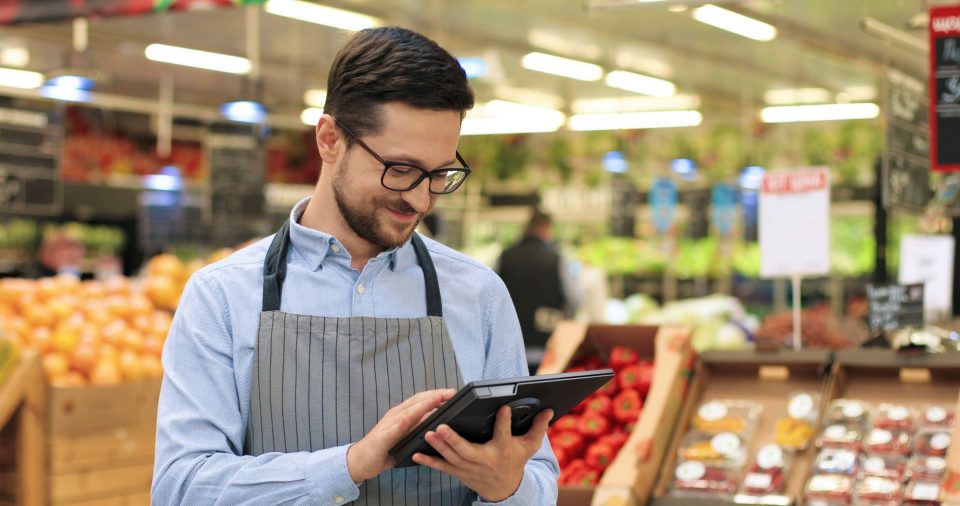Retail and Hospitality industries continue to be understaffed, despite expiry of many federal and state government support programs to which many attributed labor shortages throughout the pandemic.
Retailers coping with front-line staff shortages, are left wondering whether labor markets will bounce-back or will the problem persist, impacting their long-term operations.
Figure 1: Leger poll shows labor shortages impacting quality of service in retail and hospitality. https://leger360.com/surveys/legers-north-american-tracker-october-26-2021/
To get ahead of the problem, leading retailers are investing in process automation, digital tasking and self-service solutions to increase operational efficiencies and deal with labor shortages impacting their industries.
Based on research from IHL Group, grocery retailers who often operate at an average of 1-1.5% margin (the slimmest margins of all retail segments), are heavily investing in robotics, mobile devices, RFID and computervision. Technologies that automate check-out process, reduce out-of-stock occurrences and optimize margins fordigital orders (where grocery retailers are often losing 3-8 points of margin per order), are of highest priority.
According to Vispera, AI-powered computer vision out-of-stock and planogram compliance provider, retailers can spend more than 60 hours per week on inventory and planogram compliance tasks and often lose up to $800 per store per week on time spent addressing out of stock issues.
A visual computing-based solution using HP Intelligent Edge and Vispera sensors can provide instantaneous out-of-stock alerts, significantly reducing retailers’ labor requirements. As inventory accuracy improves, retailers also see reduction in errors and out-of-stock revenue loss on orders fulfilled through third-party delivery vendors such as Instacart, Wolt and Deliveroo.
To increase efficiency of store staff, retailers are transitioning time-consuming paper-based tasks to streamlined digital workflows. Moving from paper-based processes to mobile devices and digital forms also reduces errors, contributing to overall process efficiency. HP’s 2021 Customer Engagement Technology Study, conducted in partnership with Incisiv, found that by 2024, 64% of retailers plan to have deployed company-owned devices across all their locations. These mobile devices are expected to assist with 73% of all store tasks, which traditionally involved paper-based or manual processes. Convertible terminals, or specialized tablets that combine the functionality of a traditional point of sale system with the agility of a mobile device, are also increasingly popular.
Figure 2: Grocery retailers turn to mobile devices, like HP Engage Go, to increase productivity
To address increasing labor costs across Europe and North America, retailers are investing in self-service technology for check-out, product information and in-store wayfinding. With self-checkout market growing at 25% year-on-year according to 2021 RBR Report, retailers are deploying self-checkout technologies at unprecedented rate.
According to UK ePOS provider WonerLane, UK grocers that were already looking to convert traditional point-of-sale (POS) to self-checkout points, further accelerated their deployment plans through the pandemic. Shoppers too embrace the new self-checkout options, with 40-60% of store transaction volume diverting to self-checkout tills.
HP’s 2021 Customer Engagement Technology Study also confirmed that self-checkout technology is a top investment priority for retailers globally. The study highlighted that 47% of retailers believe that by 2024 self-service will be the ideal in-store check-out experience, while install base of self-service kiosks is expected to top 70% year-on-year growth over the next 24 months. When properly deployed, self-checkout solutions not only help optimize in-store labor allocation, but rather empower consumers to take control of their own shopping journey.
Figure 3: Grocery retailers increase reliance on self- service and self-checkout
Whether addressing short-term labor trends or preparing for the new reality of doing business, leading retailers continue to leverage technology to gain efficiencies in their store operations. Self-service and self-check-out, digital forms and mobile tools in the hands of associates, as well as camera-based inventory optimization solutions, are just the beginning of tech-enabled process optimization efforts being undertaken by today’s leading retailers to prepare for the future. To find out more about how leading grocery retailers are using technology to optimize store processes, don’t hesitate to contact the author via LinkedIn or reach out to your local HP Retail Solutions Partner.
About the Author: Dmitry Sokolov is the Global Industry Strategist at HP working with retailers and solution providers around the world on transforming the future of retail experiences. From point-of-sale, mobility and self-service to distributed edge architectures, HP is helping retailers excel in a constantly evolving retail environment.




